This Vegan Coq Au Vin is a cosy, retro-inspired take on the classic French stew that was made famous by Julia Child. Our recipe features roasted cauliflower steaks instead of chicken, mushrooms, shallots, and a rich, glossy no-wine sauce. It's a flavour-packed main that would be perfect for a vintage or retro style or a 1960s themed dinner party or for an extra-special meal.
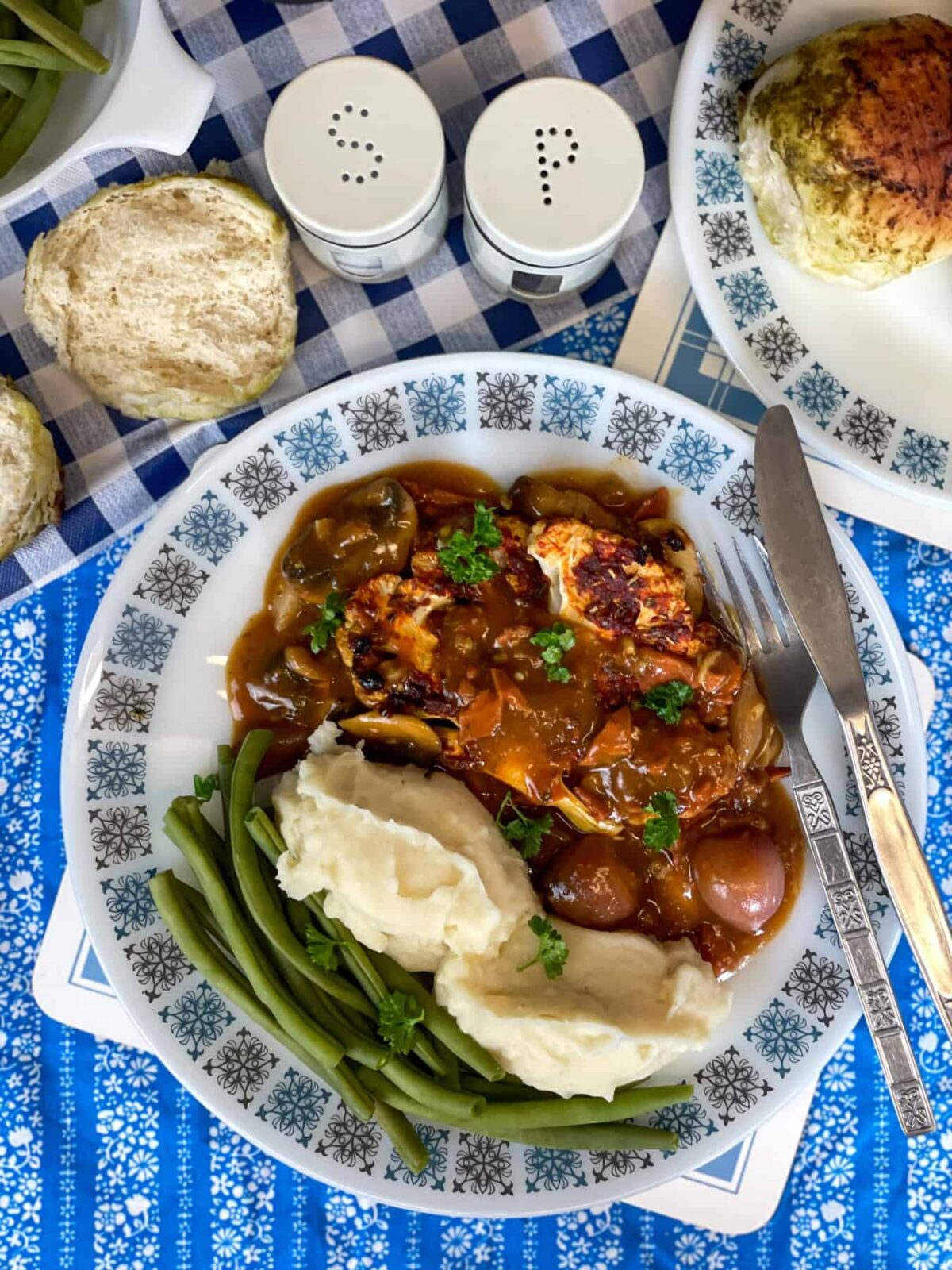
This vegan take on the classic French coq au vin features juicy mushrooms, sweet melt-in-the-mouth shallots, roasted herby-tomato cauliflower steaks, and a rich, savoury, glossy stew. If preferred you can replace the cauliflower with Portobello mushrooms, vegan chicken steaks, or large broccoli florets. Alternatively, you can just prepare the rich mushroom and shallot sauce and enjoy it spooned over a big bowl of mashed potatoes.
Jump to:
💚 Why You’ll Love This Vegan Coq au Vin
- Inspired by vintage & retro 1960s and 70s dinner parties, this recipe offers a vegan-friendly & plant-based version of a family favourite.
- Perfect for vegan vintage and retro themed dinner parties.
- No-wine recipe but still full of flavour and made with simple ingredients like apple juice and red wine vinegar.
- Hearty and satisfying ingredients of roasted cauliflower, mushrooms, and shallots in a thick, glossy sauce which is perfect with mash and greens.
- Flexible and budget-friendly it's easy to adapt with pantry staples and great for using up vegetables.
- Impressive but easy as it feels fancy & extra special but comes together with everyday ingredients and straightforward steps.
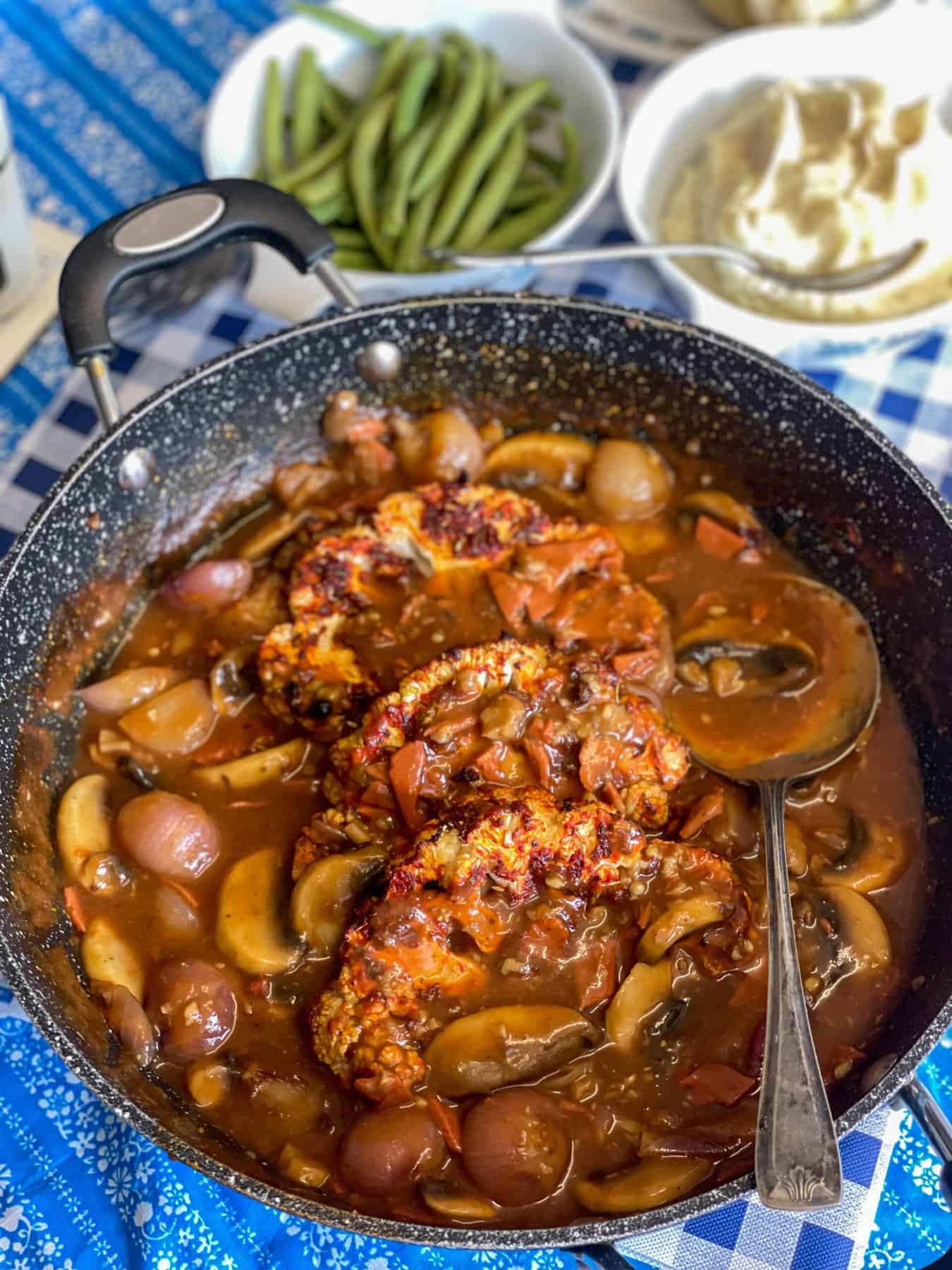
🍄🟫 Ingredients Highlights
- Cauliflower Steaks: Roasted with a home-made tomato-herb paste.
- Mushrooms & Shallots: To create that classic coq au vin texture and sweetness.
- No-Wine Sauce: A rich mix of vegetable stock, tomato passata, red wine vinegar, soy sauce, and apple juice is all you need.
- Vegan Bacon: Optional, but adds smoky depth (can be replaced or skipped).
What is a Coq Au Vin?
If you are interested in finding out about the origins of Coq Au Vin then click the toggle '📜' below.
📜 What is a Coq Au Vin?
Coq au vin is a classic French Provencal or traditional French country cooking meal from Burgundy, that is made up of chicken or rooster cooked in red wine such as Burgundy wine, along with lardons or bacon, mushrooms, and little pearl or baby onions. The name "coq au vin" translates to "rooster with wine," which reflects the meals origins in medieval peasant food as it was made with old roosters that were slow-cooked in wine.
Julia Child's coq au vin recipe
During the 20th century coq au vin was made popular by The French Chef Julia Child, who featured Coq au Vin or Chicken in Red Wine with Onions, Mushrooms, and Bacon,[p277-278] in her cookbook "Mastering the Art of French Cooking" [1961] and on her US television show ''The French Chef''[1963-1973]. It soon became a popular British retro dinner party meal.
Coq au vin was still going strong into the 1980s as Delia Smith, the popular English cook, included a recipe for coq au vin within her 1983 edition of Delia Smith Complete Cookery Course [pg 214] and she described the dish as ''a splendid dinner party dish'' [pg215].
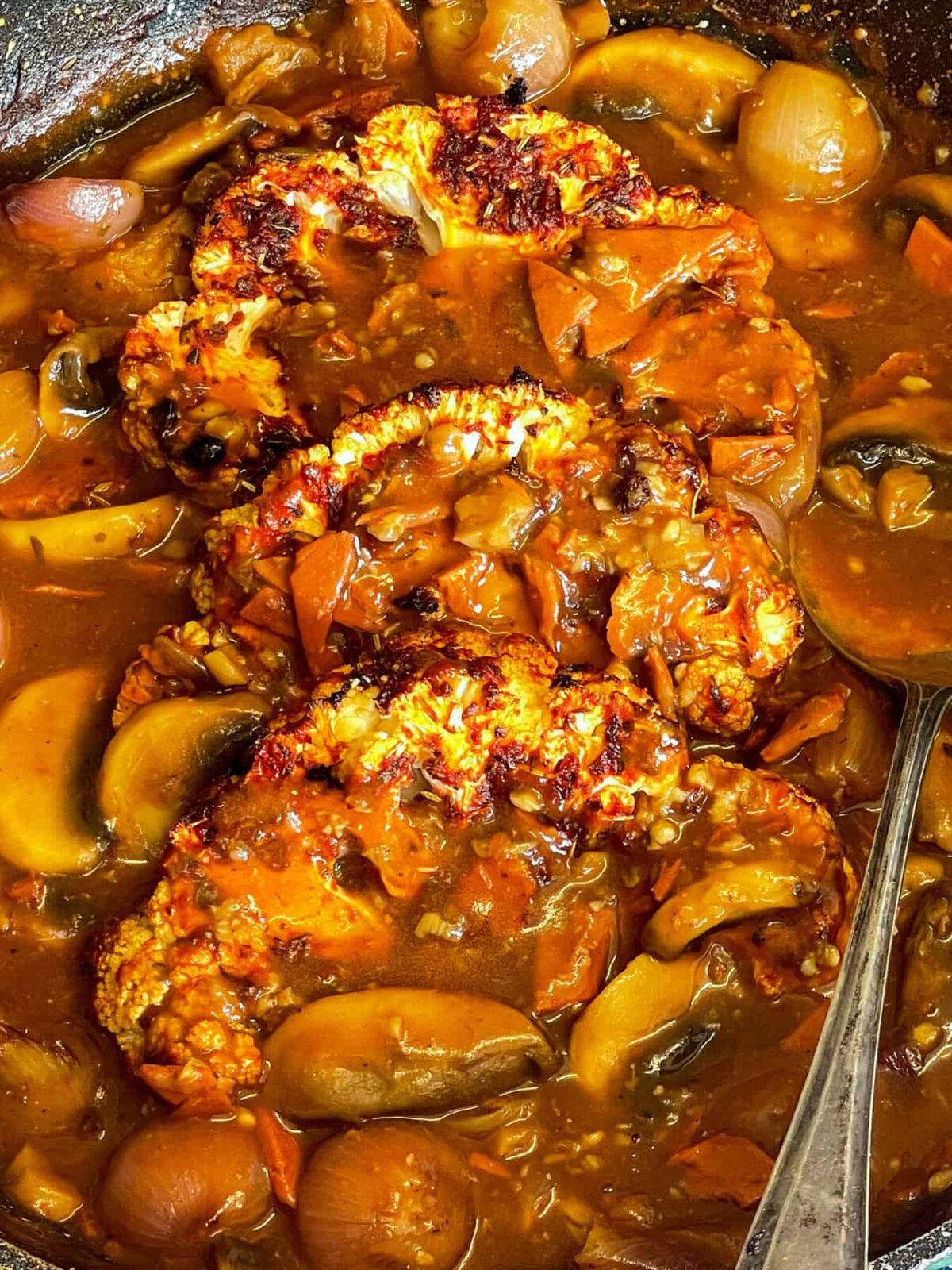
Retro recipes may be making a come-back but vegan & plant-based versions are also becoming very popular. Vegan Coq Au Vin is so delicious for a special meal such as Mother's Day, Father's Day, Easter, Christmas, New Year, Birthday meal, retro dinner party, 1960's themed meal, vintage menu, or just for any day of the week.
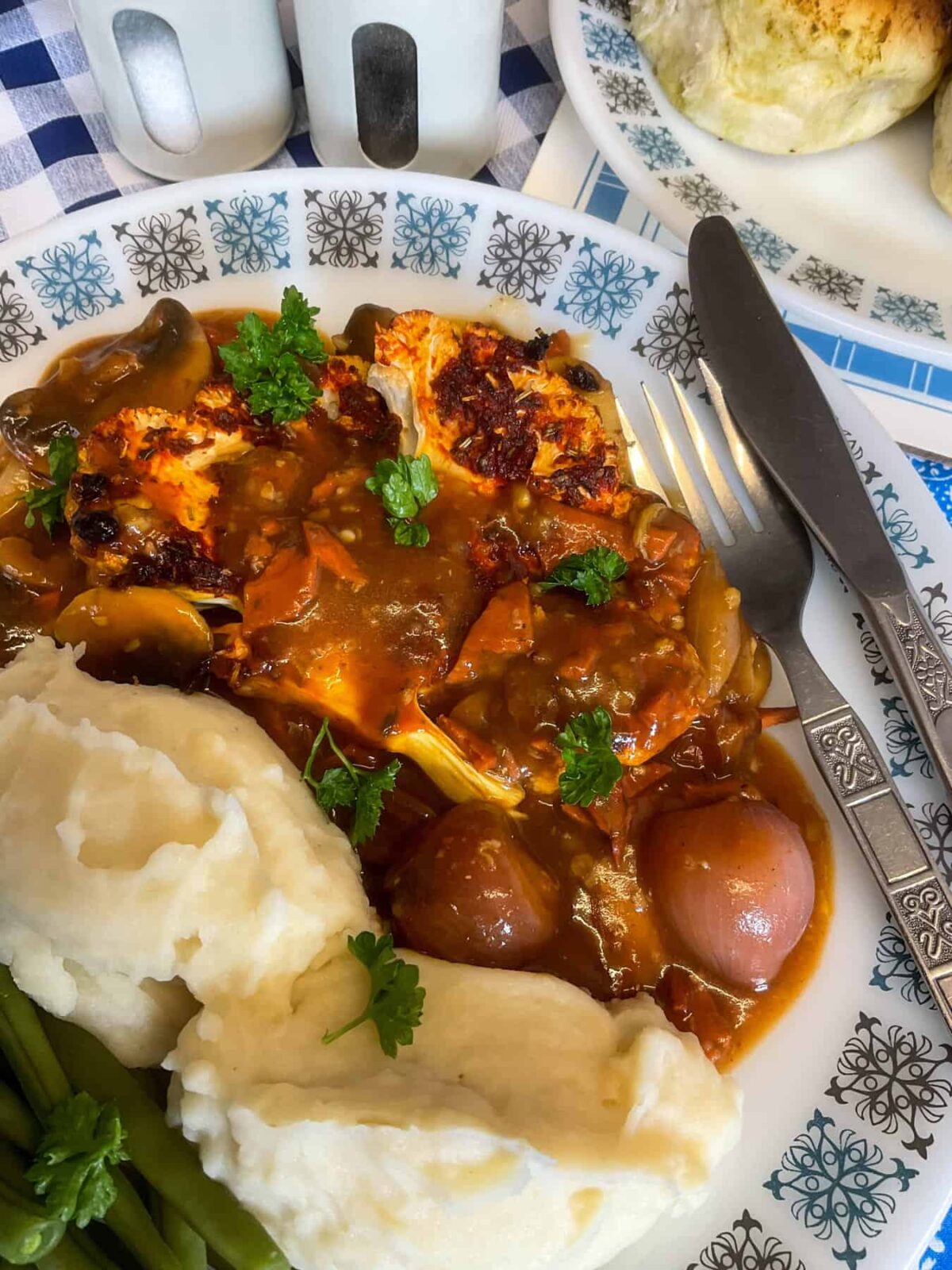
How to prepare
Preparing this vegan coq au vin recipe is nice and easy. While the cauliflower steaks are roasting in the oven the sauce can be prepared so that the meal is ready once the cauliflower is cooked. To save time, you can prepare the cauliflower a day in advance and store within the refrigerator until ready to roast. Additionally, the onions, mushrooms, and garlic can be prepped a few hours in advance.
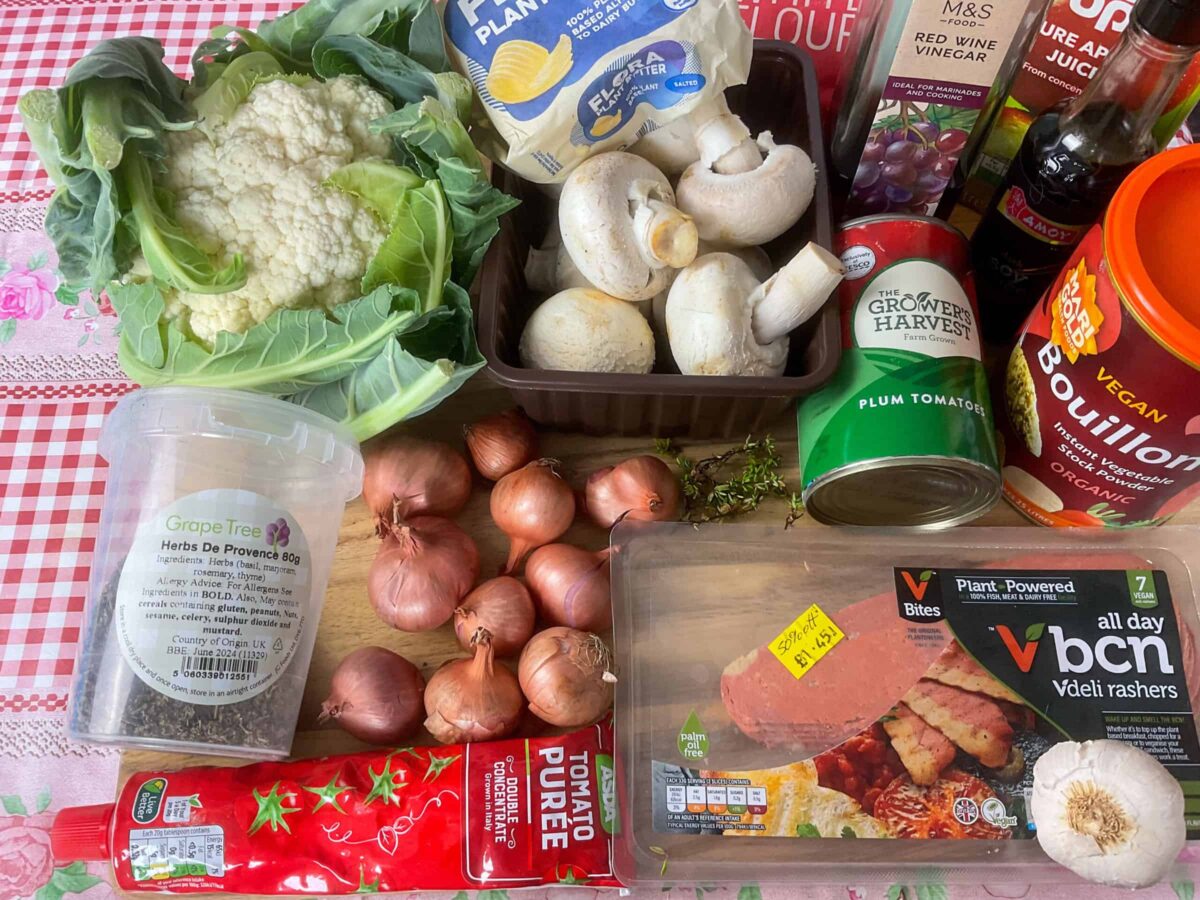
Step 1: First, gather all your ingredients and prepare the fresh ingredients: mushrooms, cauliflower steaks, shallots or pearl onions, garlic, and thyme leaves.
Prepare the sauce ingredients:
Step 2: Add the vegetable stock, tomato passata or an alternative [see the recipe notes for some suggestions: we had run out of passata so blended up a can of plum tomatoes], red wine vinegar, soy sauce, and apple juice to a jug, stir well and set aside until required.

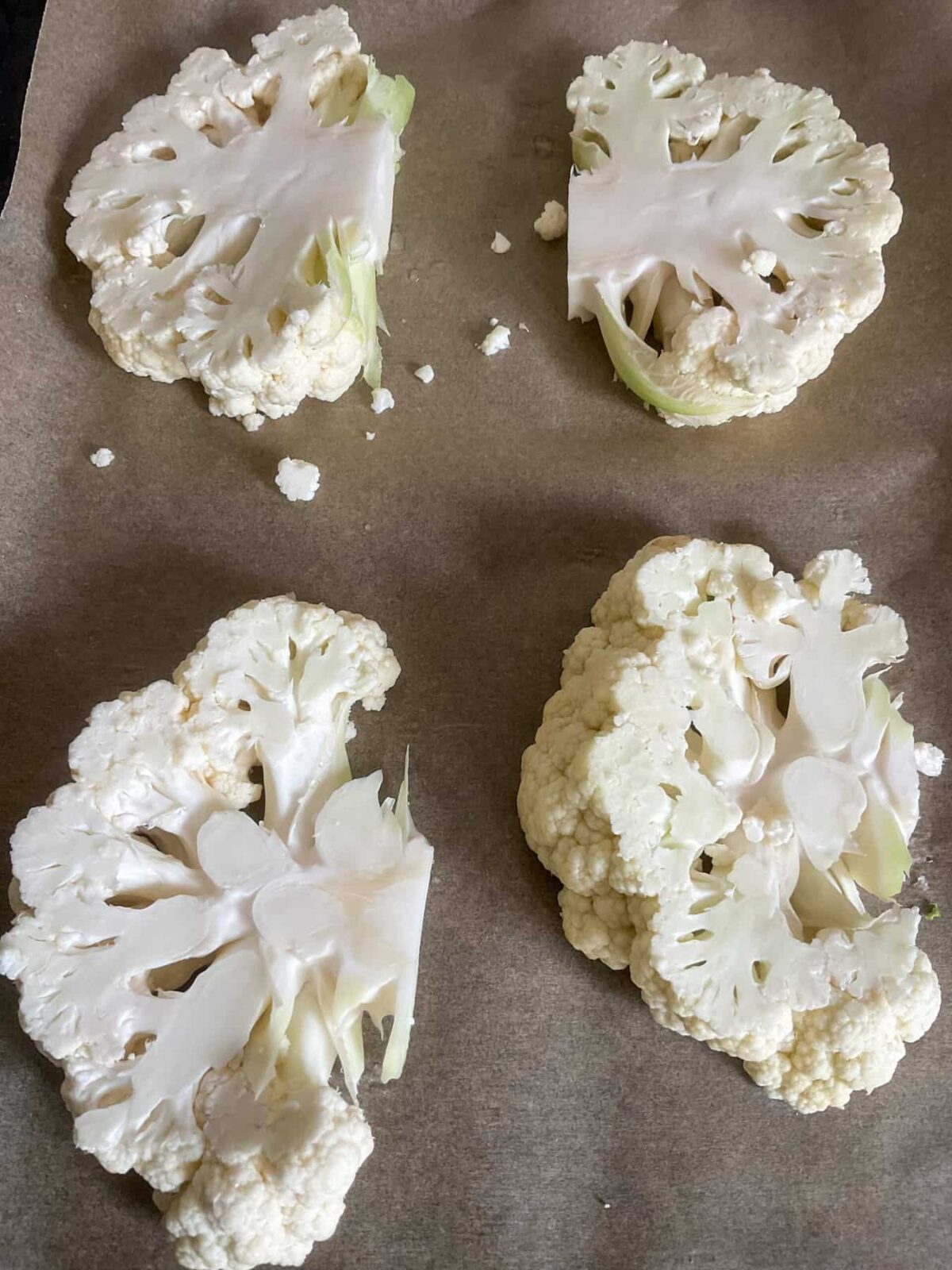
Next, prepare the cauliflower steak rub:
Step 3: Add the tomato paste, French dried herbs, sugar, and olive oil [or replace the oil with canned chickpea water] to a bowl and mix well.
Prepare the cauliflower steaks:
Step 4: Remove the cauliflower leaves and trim the stalk but don't remove too much of the base stalk as its the stalk that keeps the steaks together.
Step 5: A small cauliflower head [about 450-500grams / 15-17oz] should yield 2 thick steaks and a large cauliflower may give 3-4. We used 2 small cauliflowers and each steak weighed between 98g-115grams / 3-4 oz]. Slice the cauliflower down the middle right through the thick stalk. Slice another steak from each section, being careful to retain the stalk in each steak. The sides of the cauliflower will crumble into florets and these can be kept for another recipe.
Alternatively, instead of steaks, large cauliflower florets can be used.
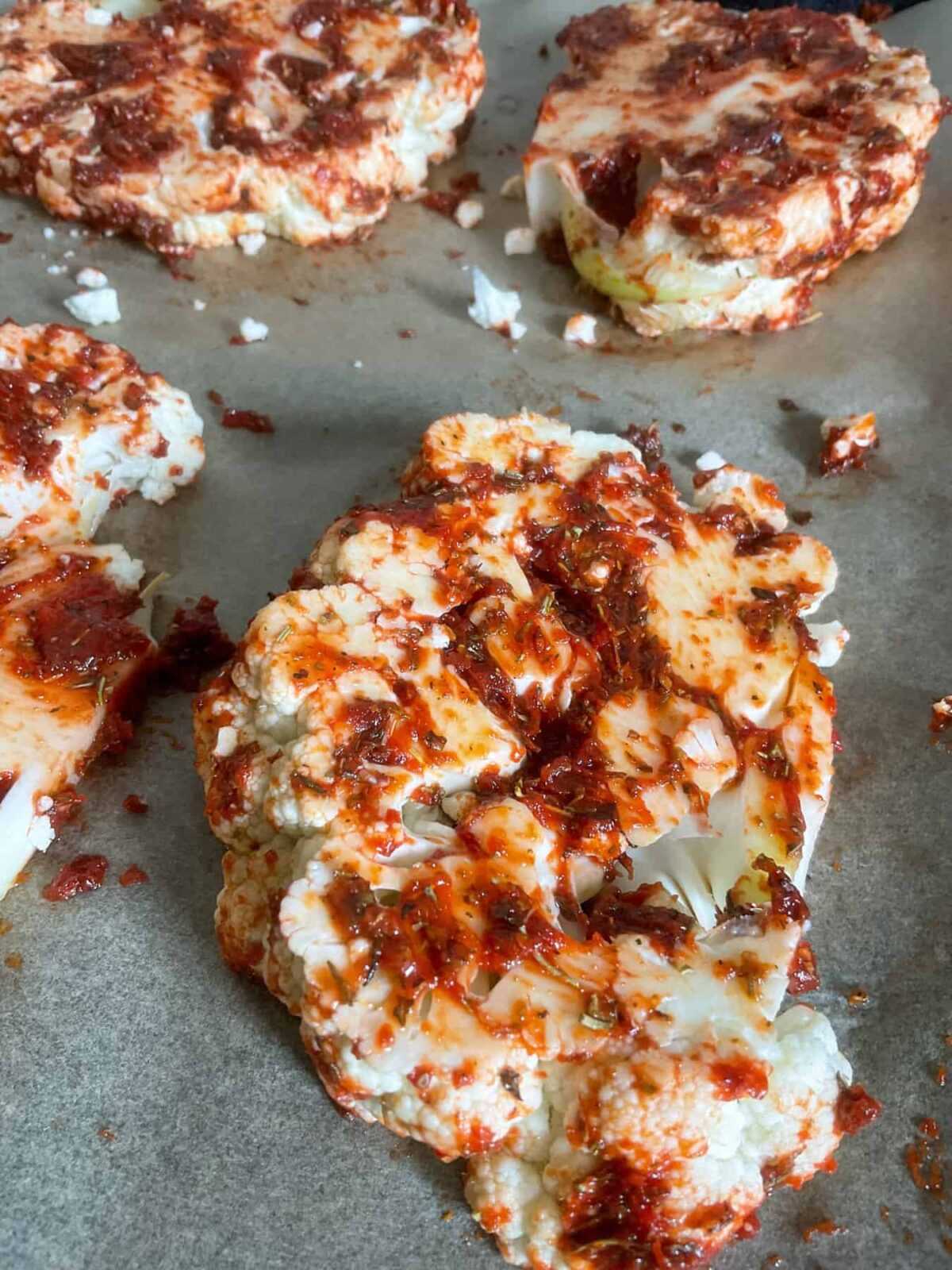
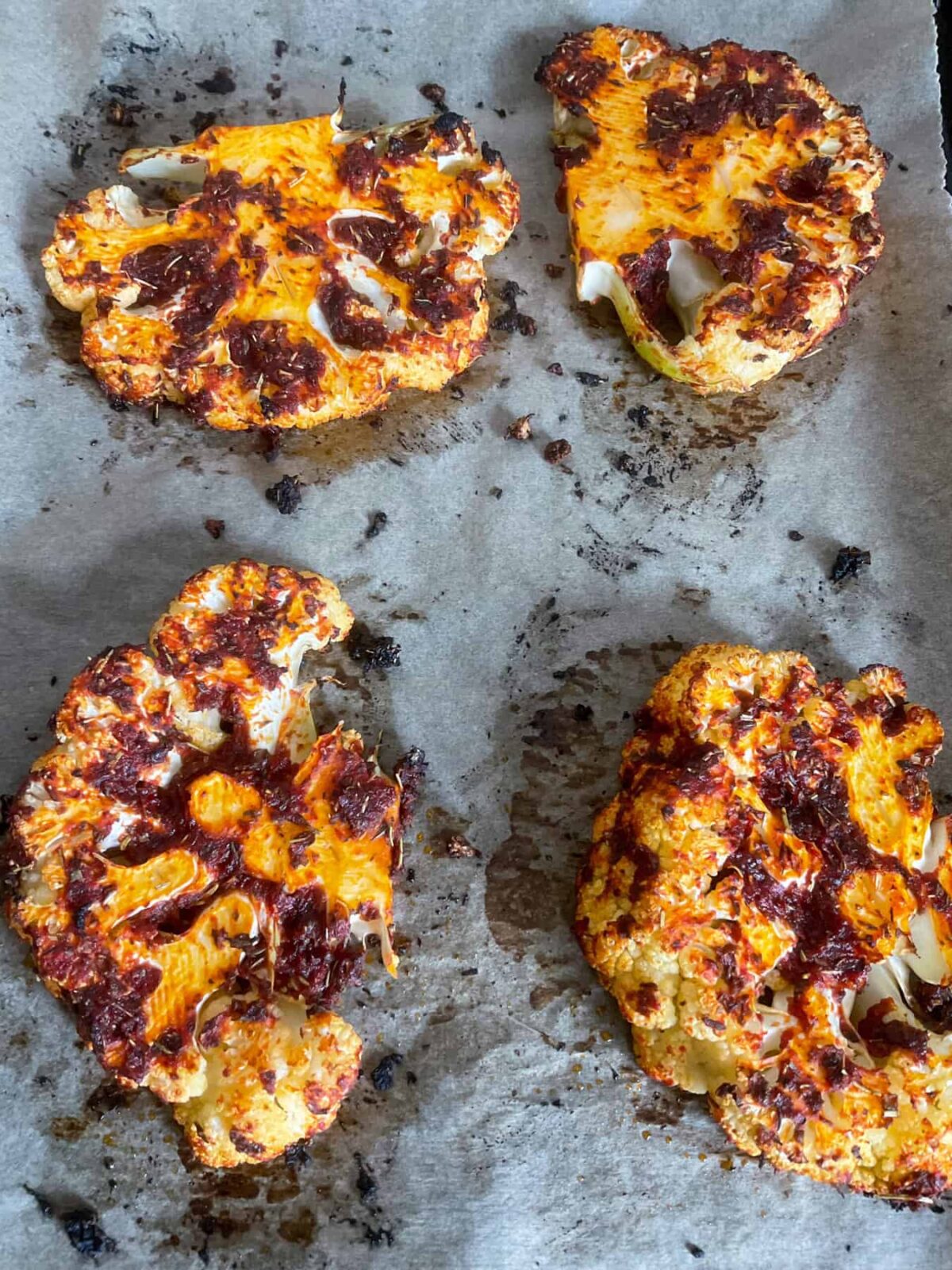
Step 6: Brush the cauliflower steaks with the tomato mixture - on its top, sides, and underneath. Roast in the oven for 25-35 minutes until the steaks are soft and cooked through. There's no need to flip them over during cooking.
While the cauliflower steaks are cooking, prepare the sauce:
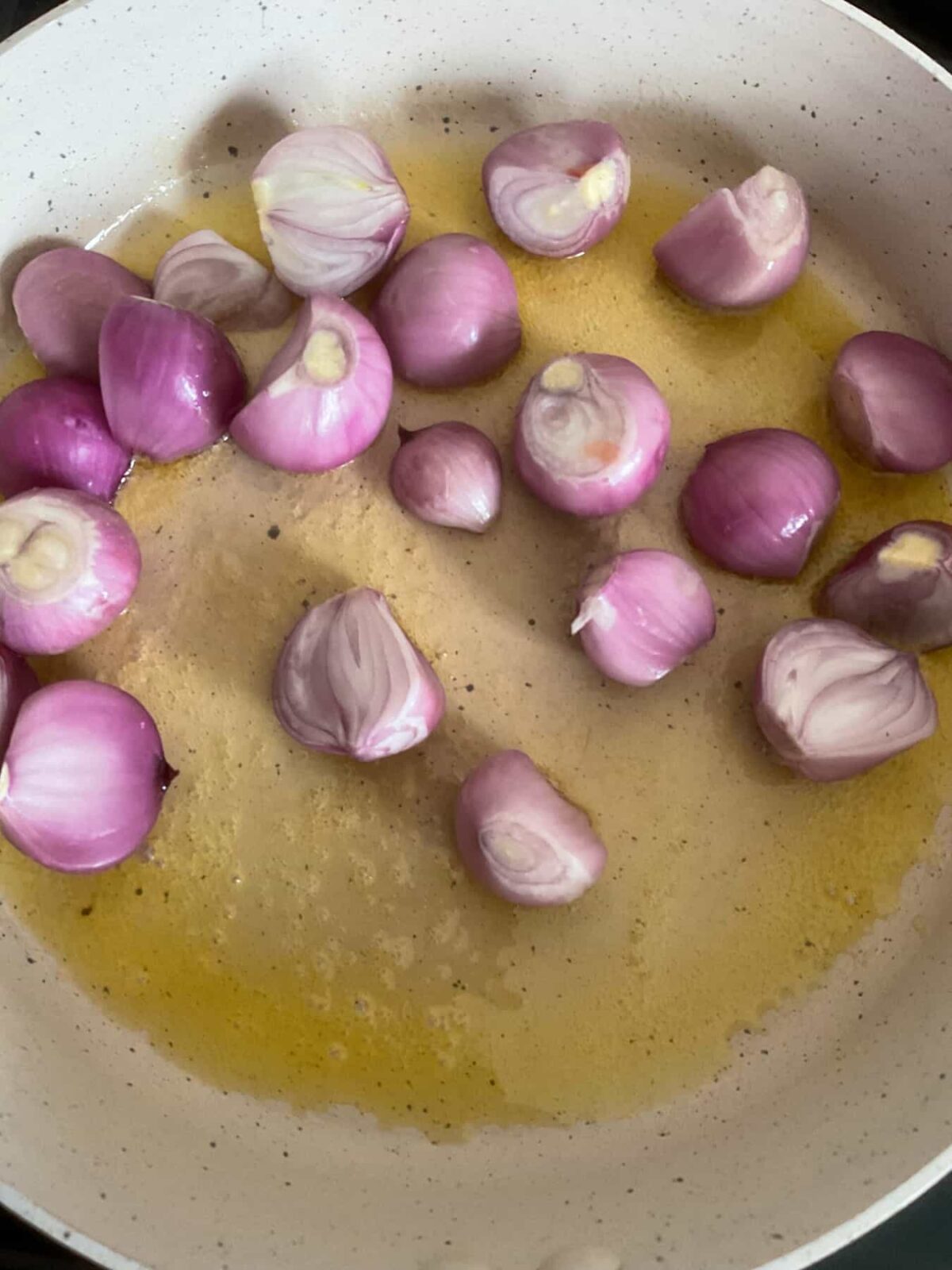
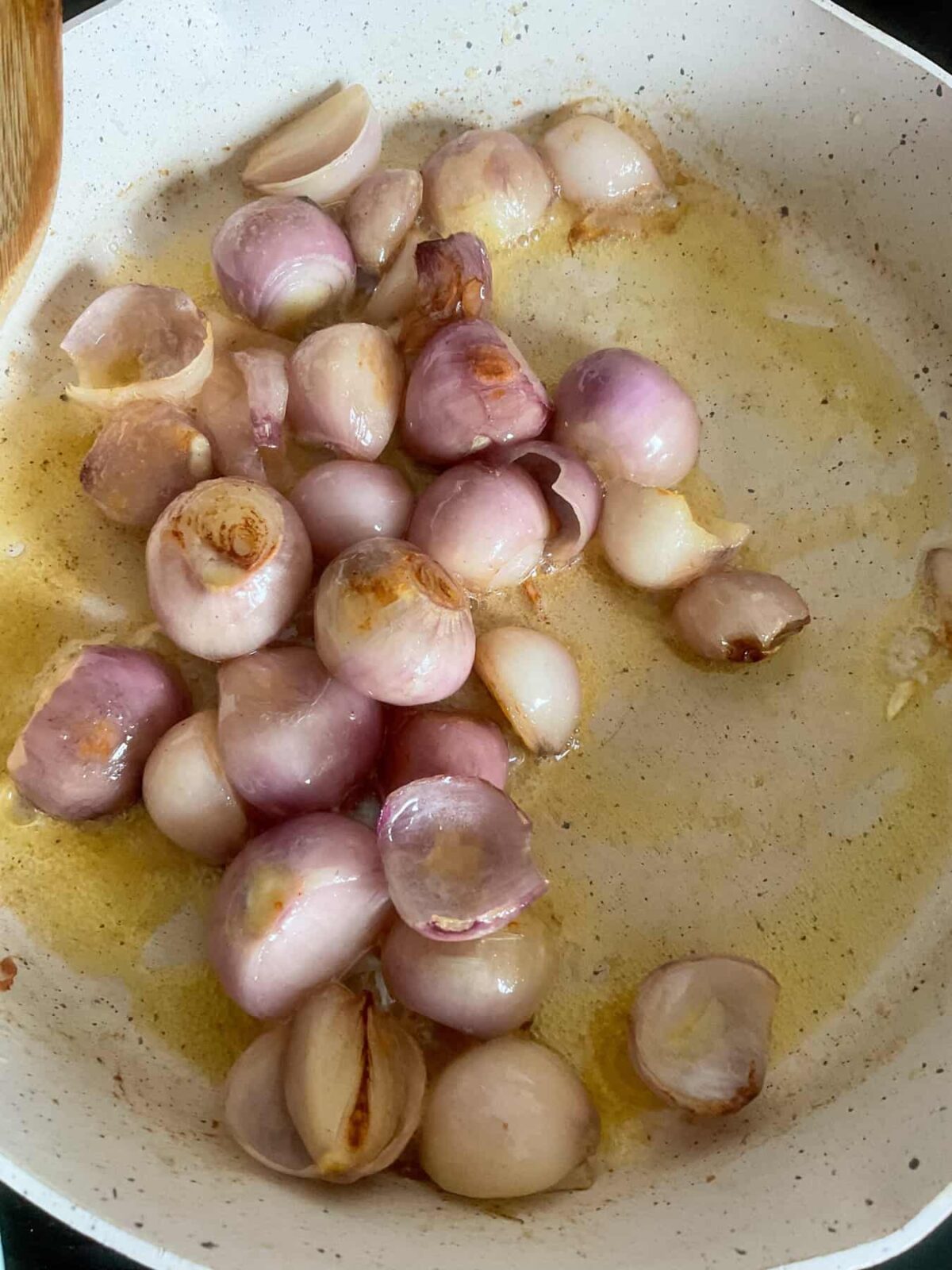
Step 7: Melt the vegan butter [or heat a ¼ cup of vegetable stock] in a non-stick pan. Add the shallots and cook for 5 minutes, stirring frequently.
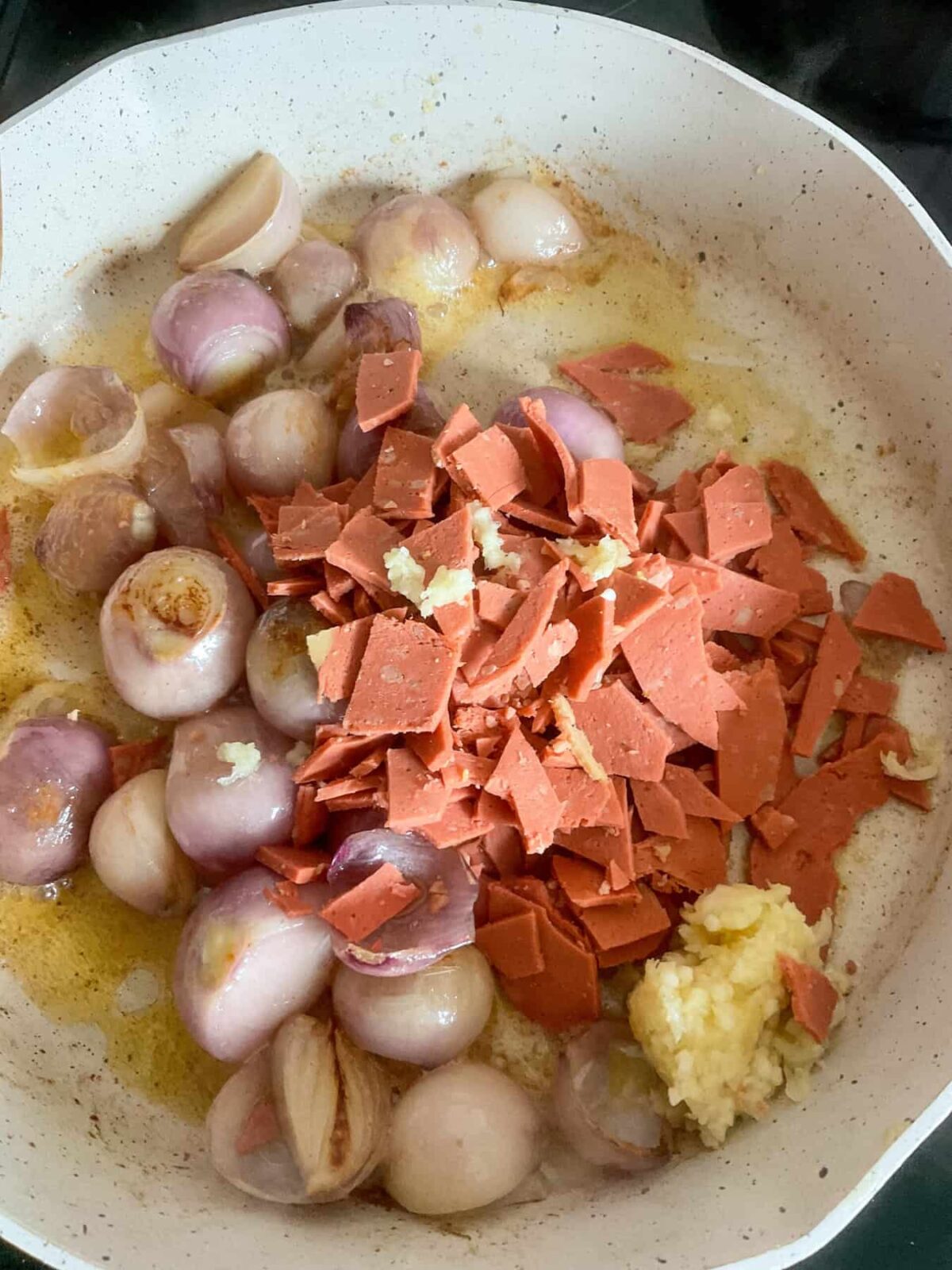
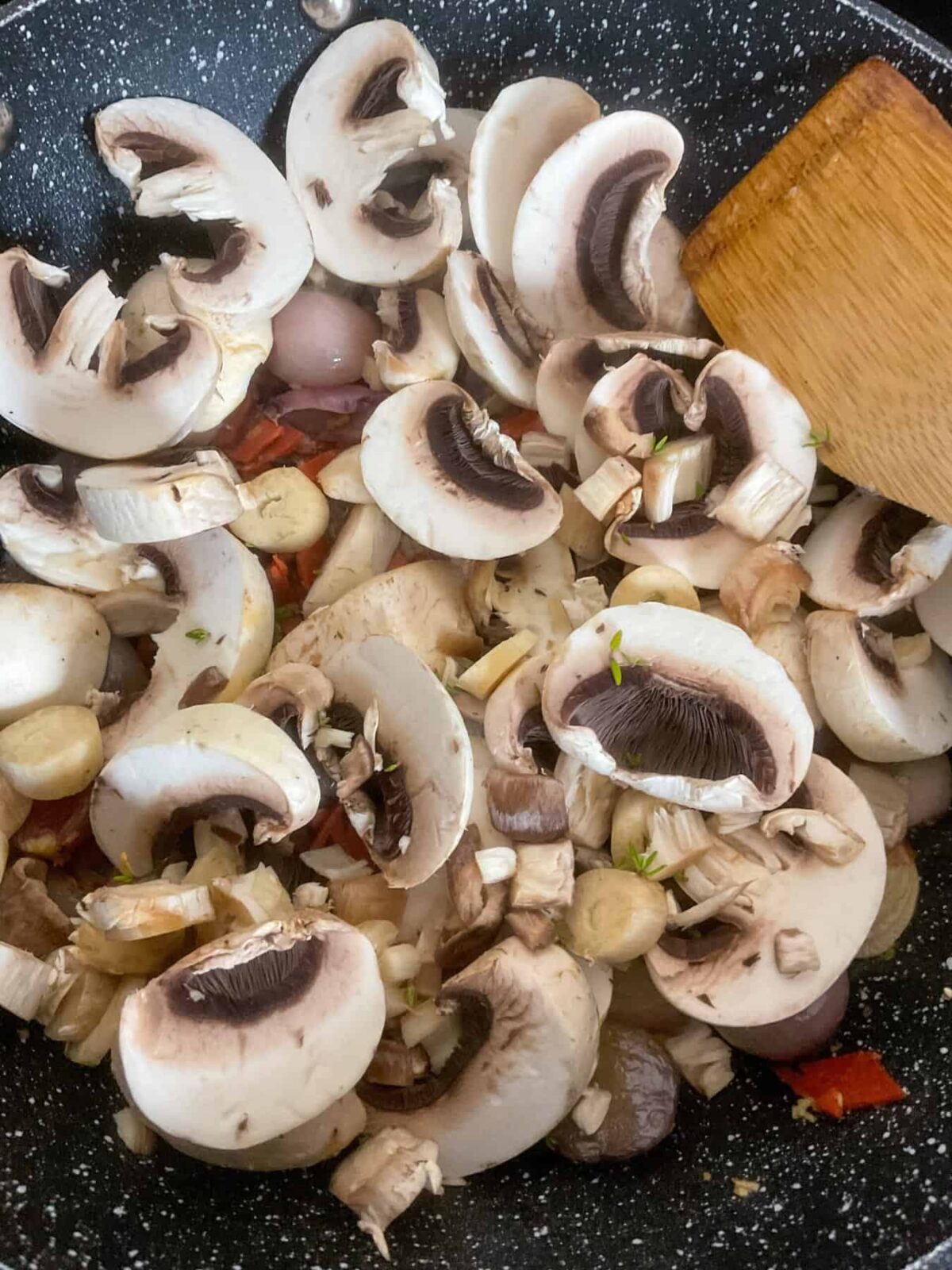
Step 8: Next, add the fine diced garlic and chopped vegan bacon pieces, cook for 3 minutes giving it a stir now and then.
Step 9: Add the mushrooms and pluck the leaves off the sprig of thyme and add those. Cook for 5 minutes.
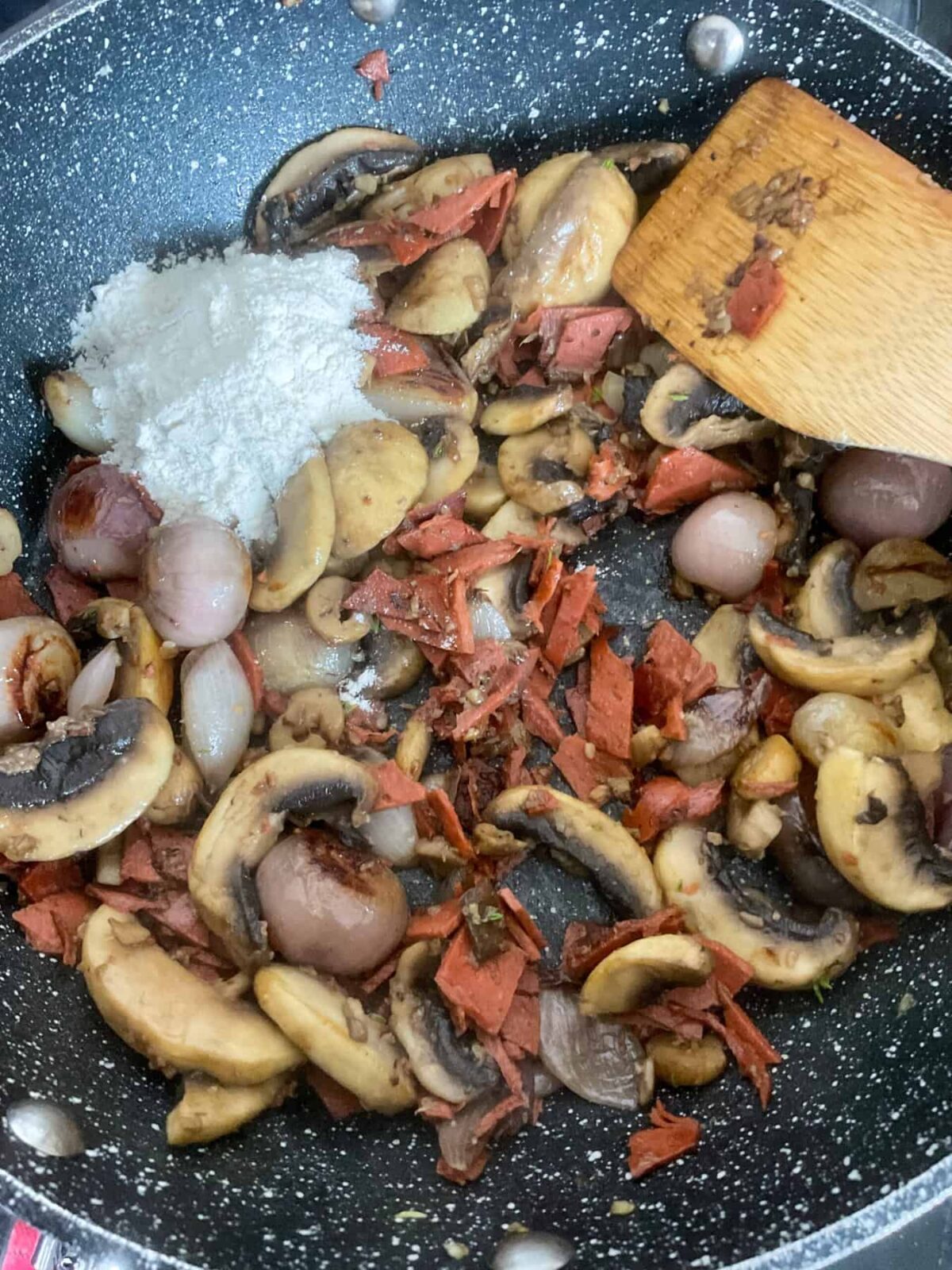
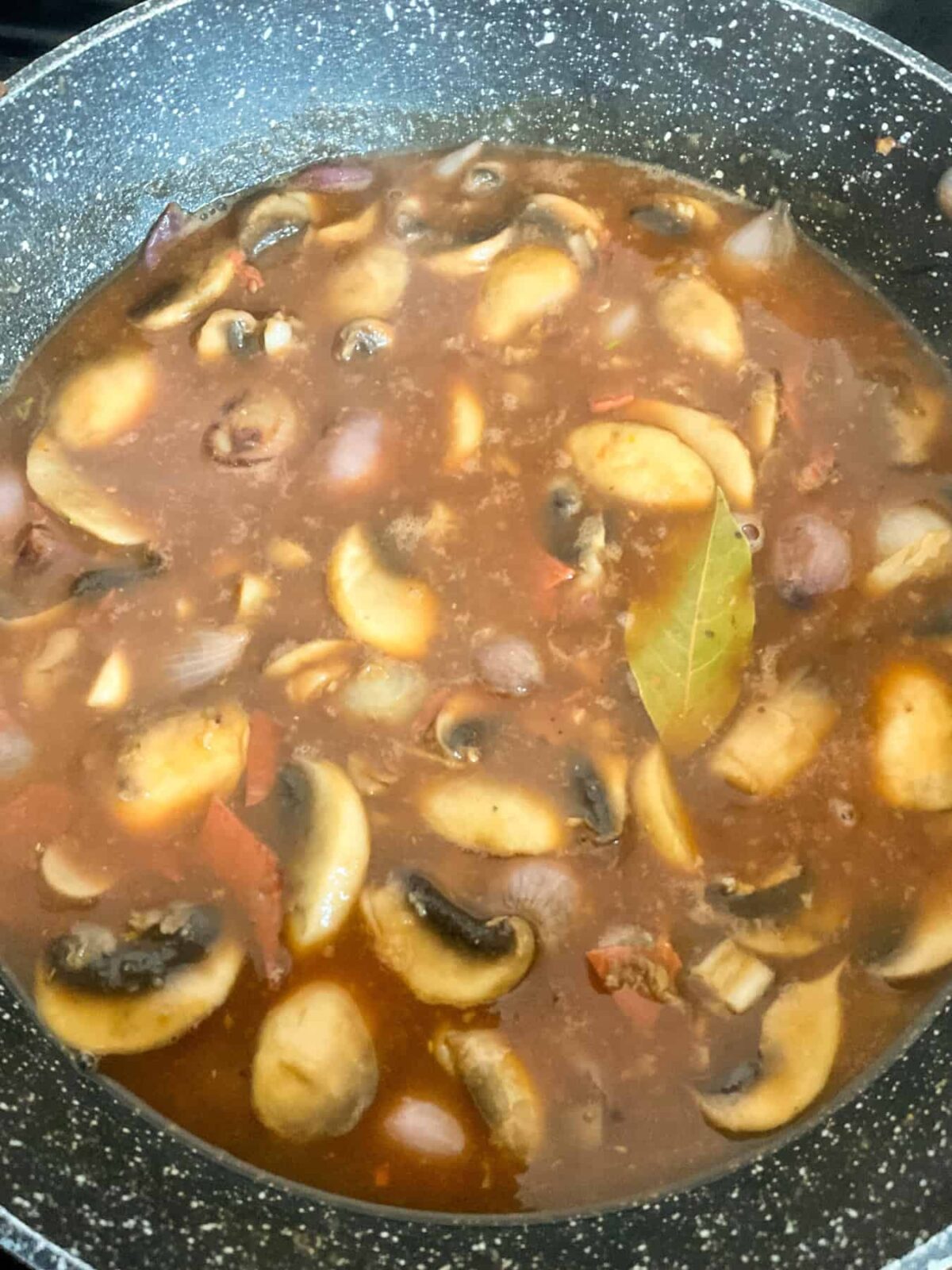
Step 10: Add in the plain flour and give it a good stir. Add the bay leaf and a pinch of salt and black pepper.
Step 11: Pour in the liquid sauce ingredients that was prepared earlier and stir well.


Step 12: Bring to a gentle boil and cook for 8 minutes until the sauce is thick, glossy, and delicious.
Step 13: Nestle the cooked cauliflower steaks into the pan or dish up the hot cauliflower steaks on to each dinner plate and spoon over the tasty sauce.
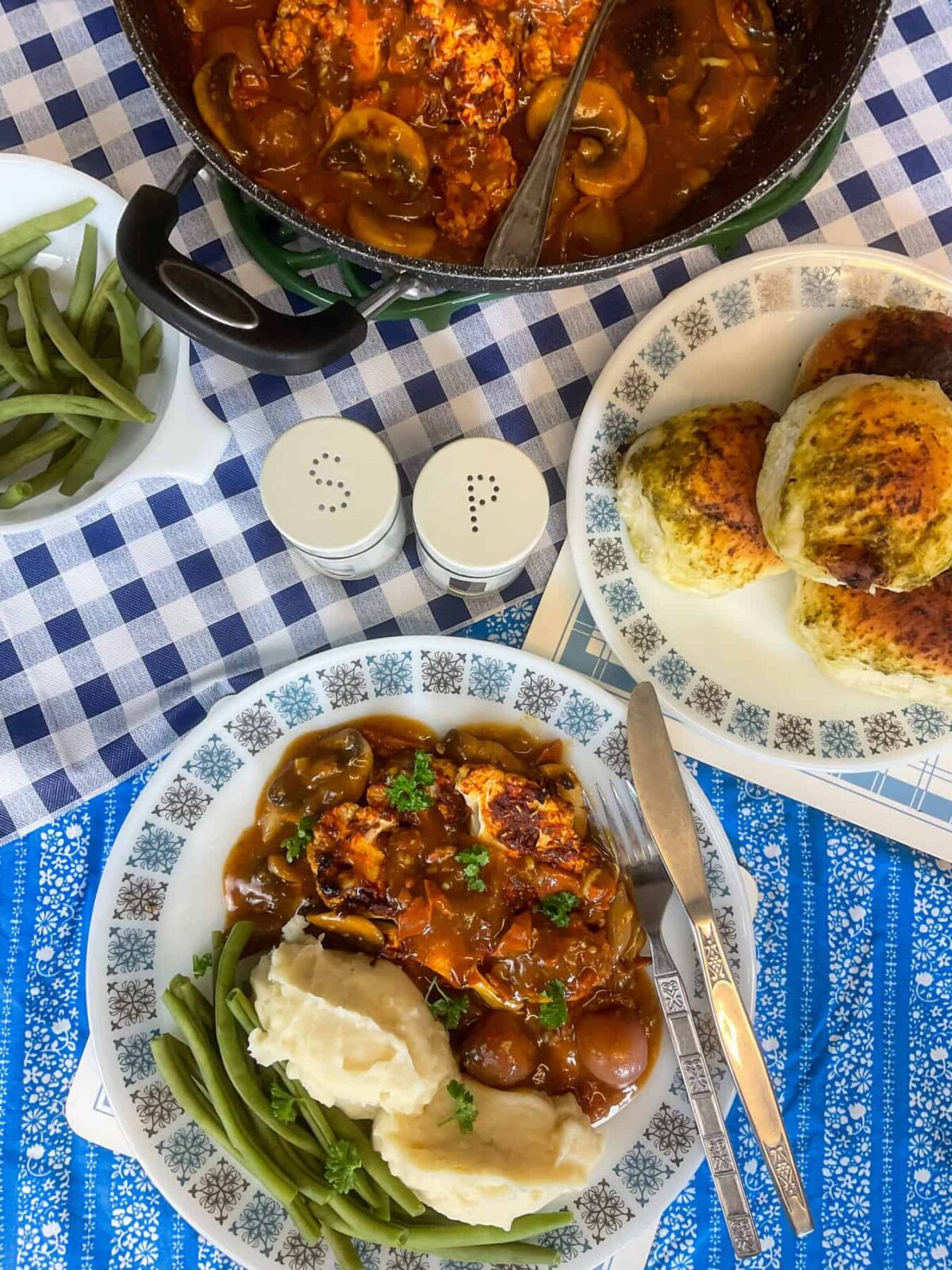
Serving suggestions: Garnish with fresh parsley if liked, and serve with sides such as mashed potato and green beans. Crusty bread or dinner rolls is a nice addition.
***please note: for US measurements click the 'US customary button' within the recipe and the measurements will switch to tablespoons, cups, and ounces.***
📖 Recipe
Vegan Coq Au Vin
Equipment
- Non-stick deep fry pan or skillet
- Baking tray, lined with parchment paper
- small mixing bowl
- Measuring jug
- cooking spatula
Ingredients
Roasted cauliflower:
- 500 grams cauliflower [sliced into four 100-115gram [3-4oz] steak shapes, use one large cauliflower or two medium-small, you'll likely have leftover cauliflower for a different recipe]
- 2 tablespoons tomato puree [tomato paste]
- 1 tablespoon dried herb mix [we used a French dried herb mix but any mix will do, or go with a vegan-friendly chicken seasoning mix]
- 1 teaspoon sugar [use your choice of sweetener, we used granulated sugar]
- 1 tablespoon olive oil [or your preferred oil, can replace with 1 tablespoon of aquafaba which is canned chickpea water]
Ingredients for stew [mix all together]:
- 400 millilitres vegetable stock
- 1 tablespoon soy sauce
- 120 mililitres tomato passata [or canned tomato sauce / canned or jarred sieved or strained tomatoes, or blend a can of chopped, diced, or plum tomatoes]
- 3 tablespoons red wine vinegar
- 65 millilitres apple juice
Rest of stew ingredients:
- 25 grams vegan butter [or replace with ¼ cup of veggie stock and add more as required]
- 200 grams shallots [halved if large and kept whole if small or use pearl onions, or sliced ordinary onion into even sized thick chunks]
- 4 vegan bacon rashers [chopped into small pieces, or replace with smoked tofu or little red beans such as pinto or azuki beans, with perhaps a 2 teaspoon sof smoked paprika for a smoky flavour]
- 6 medium garlic cloves [fine diced or minced]
- 200 grams mushrooms [thick sliced]
- 2 tablespoons plain flour [all-purpose flour or replace with gluten-free flour]
- 1 sprig thyme [pick the leaves off or simply add the sprigs, use more sprigs if liked, or use 2 teaspoons of dried thyme]
- 1 bay leaf
Optional, garnish:
- fresh parsley
Instructions
Prepare the roasted cauliflower steaks:
- Preheat your oven to 180°C (160°C Fan) / 350°F / Gas Mark 4.
- Add the tomato puree, dried herbs, sugar, and oil to a small bowl and mix well.2 tablespoons tomato puree, 1 tablespoon dried herb mix, 1 teaspoon sugar, 1 tablespoon olive oil
Prepare the cauliflower steaks:
- Remove the leaves and trim the stalk but keep the core intact as it will hold the steaks together. Slice the cauliflower in half directly down the middle and through the core.500 grams cauliflower
- Now slice each half into steaks about an inch [2-3cm] wide being careful to keep part of the core and bottom stalk on each steak. Depending on the size of your cauliflower you may need 2 to achieve 4 good steaks. Don't worry if one of the steaks breaks apart as it can still be used for the recipe.Our 4 steaks weighed about 98-115grams [around 3-4 oz] each.[There is a link below in the recipe notes to a YouTube video demonstrating how to slice a cauliflower steak].
- The sides of the cauliflower will crumble into florets as its cut as there will be no core or stalk to hold these together. The crumbled florets can be used for another recipe.
- Lay each steak onto a baking sheet lined with parchment paper if necessary. Rub the tomato paste mixture all over each steak being carefully not to break up the cauliflower.
- Roast for 25-35 minutes or until the steaks are completely cooked through. There's no need to flip the steaks half way through cooking.
Prepare the stew liquid ingredients:
- Add the vegetable stock, tomato passata, red wine vinegar, and soy sauce to a jug and stir well.400 millilitres vegetable stock, 1 tablespoon soy sauce, 120 mililitres tomato passata, 3 tablespoons red wine vinegar, 65 millilitres apple juice
While the steaks are cooking cook the stew:
- Melt the butter in a non-stick pan and add the shallots or baby/pearl onions. Cook for 5 minutes over a medium heat, stirring frequently.[use ¼ cup of vegetable stock instead of oil if preferred]25 grams vegan butter, 200 grams shallots
- Next, add the fine diced garlic and chopped vegan bacon and cook for 3 minutes, stirring frequently.4 vegan bacon rashers, 6 medium garlic cloves
- Now add the mushrooms, bay leaf, and thyme leaves and cook for 5 minutes. It may be necessary to add a little extra oil [or small amount of vegetable stock if using this as an oil alternative] to help the mushrooms to cook.200 grams mushrooms, 1 sprig thyme, 1 bay leaf
- Sprinkle in the flour and stir so that it looks like it has disappeared.2 tablespoons plain flour
- Next, pour in the stew liquid mixture that you mixed together earlier in a jug. Season with a few pinches of salt and pepper, although don't add too much salt just now as it will likely not need much seasoning and the flavours will concentrate as the stew cooks.
- Stir well and bring to the boil, lower the heat and gently simmer for 8 minutes until the sauce is thick and glossy, and the onions have cooked through. Remove the bay leaf and check the seasoning adding salt and pepper if necessary.
Assemble the coq au vin:
- The cauliflower steaks can be nestled into the stew in the cooking pan once both are ready, or place a cauliflower steak onto a dinner plate and ladle over the thick stew. Garnish with a sprinkling of fresh parsley if liked.fresh parsley
Optional serving suggestion:
- Enjoy with sides of mashed potato, green beans, and crusty bread or dinner rolls.
Notes
- Nutritional information: This is provided for guidance only and is not intended to be an exact analysis as ingredients can vary.
- Cauliflower Steaks: The core of the cauliflower helps to hold the steak together, so it's important not to cut it off. If you're new to making cauliflower steaks, don't worry if the first one or two don't turn out perfect as it takes a bit of practice to get the slices just right. Any pieces that break off can be saved for another recipe or simply roasted and used the same way the steaks are, the flavour will still be the same! For a useful video that demonstrates how to easily cut a cauliflower steak have a look at this quick one on YouTube.
- Herbs: The recipe calls for a dried French herb mix, but you can use ordinary dried herb mix. A vegan-friendly chicken seasoning mix is a nice alternative.
- Vegan Bacon Substitute: If you prefer, you can replace the vegan bacon with smoked tofu or tempeh bacon, or beans, such as pinto or azuki. If you use beans, consider adding some smoked paprika to give the dish a smoky flavor. We used All Day Bcn Vdeli Rashers, which are plant-based and gluten-free, which we sourced for half price at our local wholefood shop!
- Flour: Plain flour is used which is the same as all-purpose flour. If you're gluten-free, be sure to use a gluten-free plain flour.
- Serving: This dish can be served as-is, but it's also great with some sides such as mashed potatoes, green beans, and crusty bread or dinner rolls which are all tasty choices. Check out the recipe notes and FAQ section above for more suggestions.
- Storage and Reheating: Leftovers can be stored in the refrigerator for up to 3 days. Or frozen for 2-3 months.
- Reheat: Leftovers can be gently reheated in a non-stick pan until piping hot, add a few tablespoons of stock if necessary. Gently flip the cauliflower steaks over so that they are reheated throughout.
- Gluten-Free: Use a gluten-free vegetable stock, gluten-free soy sauce such as Tamari or an alternative such as coconut aminos, gluten-free vegan bacon, gluten-free plain flour, and check all your packaged ingredients to be 100% sure that all are gluten-free.
Nutrition
Frequently asked questions
Yes, with a few considerations its easy to prepare this meal for gluten-free diets. Use a gluten-free vegetable stock and a gluten-free soy sauce such as Tamari, or an alternative such as gluten-free coconut aminos, and check that the red wine vinegar is also free of gluten ingredients. Also, use a gluten-free plain flour blend and if using vegan bacon and vegan butter choose ones that are also gluten-free. Lastly, its best to check all pre-packaged food to make sure that it is safe for gluten-free diets.
Yes, although the wine or vin is a traditional addition to a classic coq au vin it can be replaced with similar flavours to recreate some of the wine flavours. We use fresh apple juice, red wine vinegar, soy sauce, and vegetable stock and coupled with the tomato paste and sugar that is used for the cauliflower steak rub it all marries together nicely.
In traditional coq au vin the alcohol content in the wine is mostly cooked off, but we wanted to create an alcohol-free recipe, because we don't tend to buy alcohol and we wanted to keep the cost of the recipe down and have a recipe that it is more accessible for more people.
Of course, if preferred you can add some red wine such as a Burgundy red wine or Pinot Noir, and this addition is especially good if you have some red wine leftover that needs using up. Julia Child used 1 ¼ pints of red wine in her recipe back in the 1960s, but any amount can be used including a full bottle! If you do add some red wine then omit the red wine vinegar and reduce the vegetable stock by whatever amount of wine you add.
Julia Child also included ⅛th of a pint of Cognac, which is a type of Brandy, but for our vegan coq au vin we went with fresh apple juice as a non-alcoholic alternative.
The mushrooms provide a hearty chewy bite and savoury flavours for the vegan coq au vin but of course as with all home-cooked meals ingredients they can be substituted for another that will do just as good a job. A few ideas are eggplant, courgette, bell peppers, tofu or tempeh, cooked chickpeas, cooked green lentils, canned jackfruit, canned artichoke hearts, sundried tomatoes, roasted chestnuts, cooked carrots, cooked turnips or parsnips chunks, or green or black olives.
The cauliflower steaks could simply be replaced with medium-large cauliflower florets and cooked the same way as per the recipe. However, if you would like a different alternative try one of the following: Portobello mushrooms or flat mushrooms, tofu or tempeh sliced into thick steaks, seitan steaks, thick slices of eggplant or courgette, slices of butternut squash or acorn squash, large broccoli florets, purple sprouting broccoli, asparagus, or vegan chicken steaks or chunks. However, you may need to adjust the cooking times depending on your subsitition.
There are several options that can be used instead of shop-bought vegan bacon. A few ideas include tempeh or tofu bacon, coconut bacon, carrot bacon, eggplant or carrot bacon, sliced up pieces of vegan deli ham or meat-free slices such as Quorn vegan ham slices, or small pieces of cooked seitan.
Cooked vegan sausages, hotdogs, burgers, chunks, or pieces can also be chopped up into small pieces and used as a bacon replacement. Other ideas include red beans which can also be a nice vegan bacon bits replacement. Beans such as pinto or azuki and consider adding about 2 teaspoons of paprika or liquid smoke. Alternatively, prepare our Vegan Carrot Dog (meat-free hot-dogs) which results in delicious smoky, tangy, savoury, and sweet vegetable hot-dogs. Slice the carrot dog up into small butter soft pieces and it will make a great vegan bacon bits alternative.
If you would prefer to replace the vegan butter in this recipe, there are a few options. The main role of the vegan butter is to provide a fat for sautéing, which helps with flavour and browning of the onions, mushrooms, and vegan bacon. A few alternatives are olive oil, coconut oil, vegetable oil such as sunflower or rapeseed, or omit the oil or fat completely and go with a small amount of vegetable stock. Although, do keep in mind that different oils and fats, as well as the vegetable stock, have different flavours so the end dish will be affected by any ingredient changes.
The red wine vinegar adds some of the acidic and tangy red wine flavours that are missing from a wine-free coq au vin, but the red wine vinegar could be replaced with balsamic vinegar. Some versions of coq au vin use white wine instead of red, so, the red wine vinegar could also be replaced with a white wine vinegar or at a pinch use apple cider vinegar.
In traditional coq au vin recipes, little pearl onions are often used due to their size and sweet flavour. Also, they hold up well during the slow-cooking as they keep their shape whilst also absorbing the flavours. However, for our vegan version of coq au vin we used shallots as those were the only option available at our local supermarket, and they worked very well as they are small, and nice and sweet with a good texture. Shallots also hold their shape well during cooking. Other options include small sweet Cipollini onions, as well as ordinary yellow or brown, or white onions, or red onions, which can be sliced into thick slices or wedges so that they do not break down too much during cooking.
Any leftover uncooked cauliflower from slicing cauliflower steaks can be stored within the refrigerator for a few days and used for a different recipe.
Some ideas for using leftover uncooked cauliflower are cauliflower rice, cauliflower soup, roast cauliflower to go with a curry, cauliflower mash or add the cauliflower to mashed potatoes, or add the cauliflower to a stir-fry or to a salad.
Most often the cauliflower leaves that are removed from the cauliflower are discarded into the rubbish bin, but the leaves are very nutritious and we always use the leaves if they are unblemished. The leaves can be washed well and any very tough stalks and stems removed, and then sliced up to use in any soups, stews, curries, blended sauces, and stir-fry's.
Mashed potatoes and a green vegetable such as green beans, peas, cabbage, kale, Brussel sprouts, or sugar snap peas, are perfect sides for a coq au vin. A few other ideas include this Wartime Champ [a mash of potatoes, swede, and cabbage], mashed swede [rutabaga], mashed sweet potato, baked white or sweet potato, roast potatoes, potato wedges, thick noodles, rice, wild rice, black rice, quinoa, couscous, corn-on-the-cob, crusty bread, French baguette, dinner rolls, or fresh salad.
More retro recipes - made vegan
We love retro inspired meals so we are always on the lookout for interesting retro and vintage dishes that can be recreated into tasty vegan versions. Modern recipes may be nice but there's something comforting and satisfying about old family favourites that are brought back to life with vegan-friendly ingredients.
A few of our family favourite retro recipes are this Vegan Chicken Coriander and this Vegan Mushroom Steak Diane which is perfect for another meat-free steak dinner. We also love this Vegan Chicken Supreme which features butterbeans cooked in a creamy sauce and this Vegan Corned Beef Hash.
Comments
Prepared our Vegan Coq au Vin recipe? Do let us know how you got on with the recipe by dropping a comment below. We love hearing from you so if you have any questions or queries do get in touch. Thanks so much. Jacq x
Leave a Reply